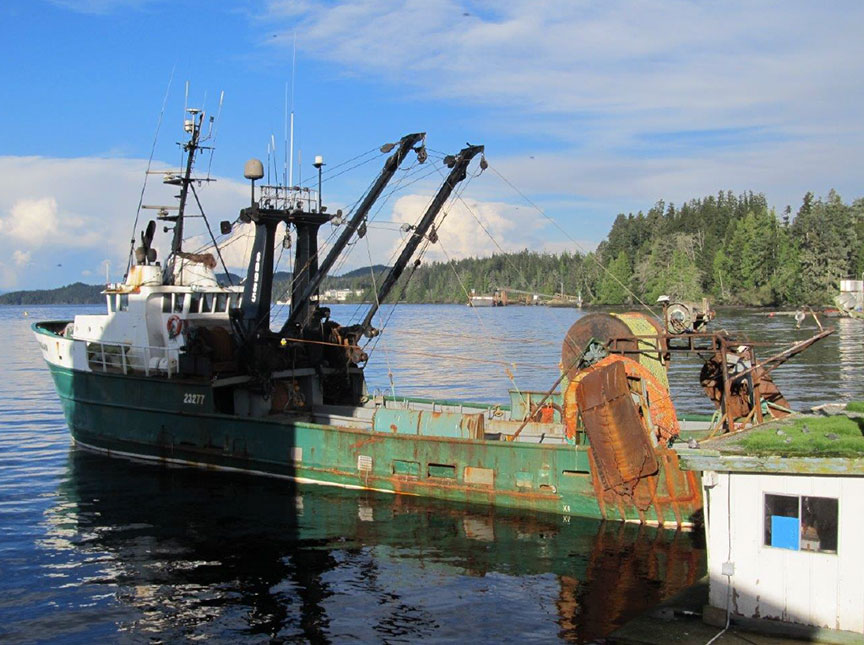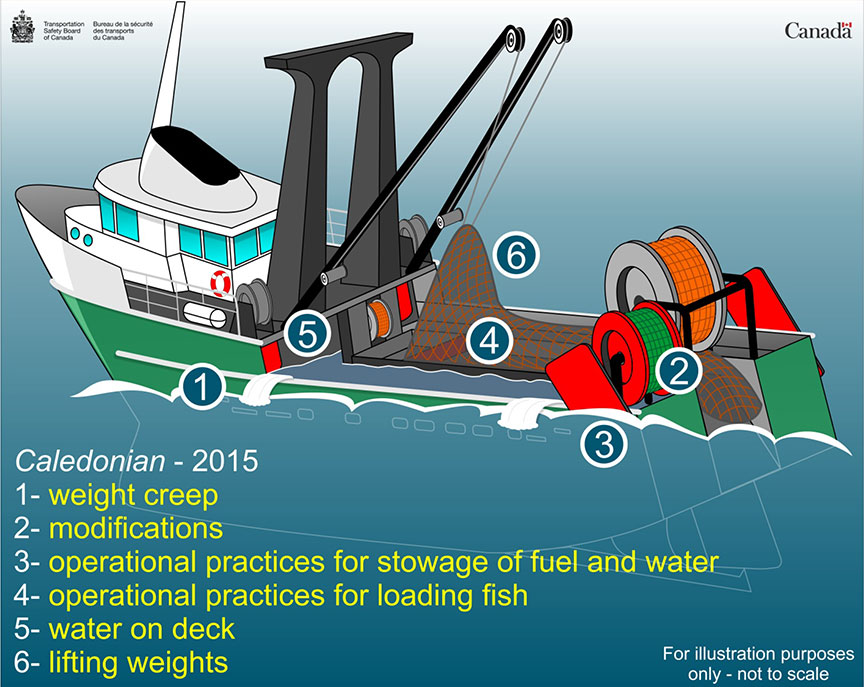Capsizing and loss of life
Fishing vessel Caledonian
20 nm west of Nootka Sound, British Columbia
The accident
On 05 September 2015, the fishing vessel Caledonian, with 4 people on board, capsized while hauling fish on board off the West Coast of Vancouver Island, British Columbia. The vessel eventually sank and minor pollution was reported. One crew member was rescued and the bodies of the remaining 3 crew members were recovered.
Safety communications
Recommendations
TSB Recommendation M94-33: The Department of Transport establish guidelines for stability booklets so that the information they contain is presented in a simple, clear, and practical format for end-users.
TSB Recommendation M16-01: The Department of Transport establish standards for all new and existing large fishing vessels to ensure that the stability information is adequate and readily available to the crew.
TSB Recommendation M16-02: The Department of Transport establish standards for all small fishing vessels that have had a stability assessment to ensure their stability information is adequate and readily available to the crew.
TSB Recommendation M16-03: The Department of Transport require that all small fishing vessels undergo a stability assessment and establish standards to ensure that the stability information is adequate and readily available to the crew.
TSB Recommendation M16-04: WorkSafeBC require persons to wear suitable personal flotation devices at all times when on the deck of a commercial fishing vessel or when on board a commercial fishing vessel without a deck or deck structure and that WorkSafeBC ensure programs are developed to confirm compliance.
TSB Recommendation M16-05: The Department of Transport require persons to wear suitable personal flotation devices at all times when on the deck of a commercial fishing vessel or when on board a commercial fishing vessel without a deck or deck structure and that the Department of Transport ensure programs are developed to confirm compliance.
Media materials
Backgrounders
Investigation findings (M15P0286) in the September 2015 capsizing and sinking of the fishing vessel Caledonian off the west coast of Vancouver Island, British Columbia
Safety communications for TSB investigation (M15P0286) into the September 2015 capsizing and sinking of the fishing vessel Caledonian off the west coast of Vancouver Island, British Columbia
Stability information for the investigation (M15P0286) into the September 2015 capsizing and sinking of the fishing vessel Caledonian off the west coast of Vancouver Island, British Columbia
Deployment notice
Transportation Safety Board of Canada deploys investigator following sinking of fishing vessel Caledonian in Nootka Sound, British Columbia
Richmond, British Columbia, 6 September 2015 — The Transportation Safety Board of Canada (TSB) is deploying an investigator following the sinking of the fishing vessel Caledonian in Nooka Sound, British Columbia. The TSB will gather information and assess the occurrence.
Media advisories
TSB will hold a news conference to release its investigation report into the September 2015 capsizing and sinking of the fishing vessel Caledonian off the West Coast of Vancouver Island, British Columbia
News releases
Stability and PFD issues led to September 2015 commercial fishing fatalities off the west coast of Vancouver Island
Read the news release
Speeches and presentations
News conference for Caledonian (M15P0286): Opening remarks
Kathy Fox
Chair, Transportation Safety Board of Canada
and
Glenn Budden
Investigator-in-Charge, Transportation Safety Board of Canada
Investigation information
Download high-resolution photos from the TSB Flickr page.
Class of investigation
This is a class 2 investigation. These investigations are complex and involve several safety issues requiring in-depth analysis. Class 2 investigations, which frequently result in recommendations, are generally completed within 600 days. For more information, see the Policy on Occurrence Classification.
TSB investigation process
There are 3 phases to a TSB investigation
- Field phase: a team of investigators examines the occurrence site and wreckage, interviews witnesses and collects pertinent information.
- Examination and analysis phase: the TSB reviews pertinent records, tests components of the wreckage in the lab, determines the sequence of events and identifies safety deficiencies. When safety deficiencies are suspected or confirmed, the TSB advises the appropriate authority without waiting until publication of the final report.
- Report phase: a confidential draft report is approved by the Board and sent to persons and corporations who are directly concerned by the report. They then have the opportunity to dispute or correct information they believe to be incorrect. The Board considers all representations before approving the final report, which is subsequently released to the public.
For more information, see our Investigation process page.
The TSB is an independent agency that investigates air, marine, pipeline, and rail transportation occurrences. Its sole aim is the advancement of transportation safety. It is not the function of the Board to assign fault or determine civil or criminal liability.


